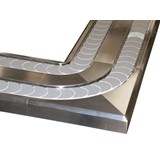Despite a raft of recent high-profile restaurant closures, IBISWorld General Manager (Australia), Karen Dobie said that strong wages growth and returning consumer confidence mean that the nation's mid-range and fine dining sectors can look forward to a renaissance over the next five years.
While value for money has been the primary concern since the global financial crisis, recovery is well underway.
"Aussies will be splashing the cash a little more when it comes to entertainment," Dobie said.
"However, recent restaurant closures at the top of the market are a reminder that even in the premium segment we're no longer willing to pay through the nose if we don't feel we're getting value for money."
Show me the money
This year Australians are anticipated to spend a total of $14.85 billion in restaurants. Premium dining venues will enjoy the largest piece of the pie ($5.94 billion), mid-range meals will receive $4.75 billion and $4.16 billion will to be spent on cheap eats.
According to IBISWorld, the fine dining segment will also experience above average growth in the five years through 2017-18, with annualised growth of 3.7 per cent to reach $7.13 billion. The broader restaurant industry is expected to grow an annualised 2.7 per cent over the next five years to reach $16.96 billion.
Currently, the average Australian household spends $220 per week in the supermarket (17.8 per cent of total weekly expenditure) compared with $67 on eating out, including fast food (5.4 per cent of weekly spend). IBISWorld data indicates growth in supermarket spending of 1.8 per cent per annum between now and 2017-18, compared with a 3.6 per cent increase on eating out.
Eating out in the east
With restaurant spending largely divided along population lines, it is little wonder New South Wales accounts for the highest proportion of dining out expenditure with 31 per cent. The next top spending state is Victoria with 25 per cent of dining out expenditure, then Queensland with 19 per cent, Western Australia with 14 per cent, South Australia with 6 per cent and the Australian Capital Territory and Northern Territory both with 2 per cent.
"Although the east coast generates the highest expenditure, both Queensland and Western Australia have grown their market share over the past decade on the back of the resources boom and resulting growth in disposable incomes," Dobie added.
Reality bites
Other factors influencing demand include market opportunities created by popular reality TV programs such as Masterchef and My Kitchen Rules. These programs have heavily promoted restaurants endorsed by celebrity chefs and led to new branches opening as the shows' stars capitalised on becoming household names.
"In addition to these successful local TV franchises, the popularity of international cooking shows, such as those featuring Jamie Oliver and Gordon Ramsay have encouraged overseas celebrity chefs to open restaurants in Australia to an audience already familiar with their brand," Dobie added.
But celebrity chefs aside, Dobie said our long working hours and busy lifestyles are a huge factor behind the trend towards eating out. This trend is one IBISWorld expects to continue as young professionals continue to eat a significant proportion of their meals away from home.
Opting for organic
While IBISWorld anticipates good times ahead for the restaurant trade, the growth in gourmet dining is hitting home too with organic food one of the fastest growing categories in Australia's supermarket sector. In 2010-11, total farm-gate sales of organic produce totalled $223 million, compared with $128 million in 2003-04, representing a growth of 74.5 per cent.
Looking ahead, Dobie expects Australians' rising health consciousness to play a part in how and where we eat out.
"Mounting concern about fat content, high carbohydrates and fried food will influence demand for certain foods on restaurant menus – stimulating change in the product mix and creating opportunities in niche markets such as organic dining and eco-consumerism."
This will likely drive some restaurateurs to differentiate their offering by promoting the use of organic or healthy ingredients or by highlighting efforts to reduce their carbon footprint – it will no longer be simply about the food, or the price.
Kings of the kitchen
Restaurants are not the only ones to benefit from Australians going back to gourmet, segments such as kitchenware are also winners from our love of foodie TV. Since 2007, Australian spending on kitchenware has grown by 3.3 per cent to $202 million, with IBISWorld expecting an additional annualised growth of 2.3 per cent over the next five years.



